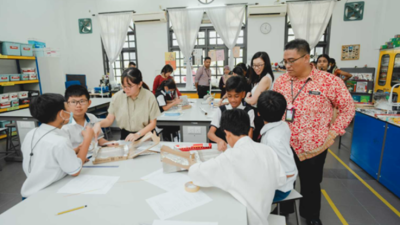
The World Intellectual Property Organisation (WIPO) recently unveiled its newest edition of the Global Innovation Index (GII) on September 26.
While our performance in terms of ranking has improve, moving up to 33 from 36 previously, our GII score have dropped slightly from 40.9 to 40.5.
While it may seem counterintuitive for our country to experience a lower score yet rank higher, the reality is that other countries have also witnessed declining performance.
As highlighted by WIPO in the GII 2024 report, investment in innovation witnessed a major downturn during 2023, with scientific publications dropping by 5.3 per cent, and venture capital deals in both numbers and values declining by 9.5 per cent and 39.7 per cent respectively.
In addition, the world seen 1.8 per cent lesser patent fillings in 2023.
Therefore, our decrease in score but higher ranking may be attributed to the fact that we did not suffer as severe a decline as other nations did.
Nonetheless, when comparing our performance to that of previous years, it is evident that we have not made any significant progress in effectively turning innovation inputs into outputs.
If anything, our result in GII 2024 is the prime example of how investment does not necessarily lead to successful output.
In EMIR Research’s (ER) previous publication titled “Navigating Malaysia’s Innovation Landscape: Unpacking the Global Innovation Index 2023”, we delved into the GII 2023 results, where one of the conclusions was that Malaysia heavily focuses on financial investment.
However, our nation’s key challenge remains in transforming these investments into meaningful results.
This statement still holds true.
Despite years of substantial financial investment, our output in GII 2024 is not at all best, scoring only 30.9 in “knowledge and technology outputs” and 31.7 in “creative outputs.”
Notably, our knowledge and technology outputs have declined from 32.2 in GII 2023, while our ranking has improved by 2.
Across the 14 sub-indicators within “knowledge and technology outputs” pillar, we observe many cases of stagnation or decline, with only “citable documents H-index” and high-tech export (percentage of total trade) showing improvement.
Even though our “citable documents H-index” score has improved, we have actually produced fewer scientific and technical articles per billion PPP$ USD.
Furthermore, our labour productivity growth decreased further from 1.3 per cent in GII 2023 to 1.1 per cent.
Our production and export complexity also experienced a dip, with the score plummeting from 75.9 in GII 2023 to 66.9, marking the lowest score for this sub-indicator since its introduction in GII 2021.
At the same time, the ICT service export dwindled considerably from 1.6 per cent of total trade in GII 2022 to 1.2 per cent as of the latest figure.
These trends are concerning.
For one, these declining trends suggest that despite heavy investment, the quality of our input has deteriorated over the years. This is something that ER highlighted in our previous article.
The improvement in GII 2023 mainly resulted from financial investment as industries gradually resumed normalcy after the pandemic.
Concurrently, human resources related sub-indicators, including the number of researchers and research talent in businesses, have been on decline.
Although we consistently maintain our top 10 position in the “graduates in science and engineering” sub-indicator, brain drain causes many graduates to leave Malaysia for a greener pasture overseas.
This situation contributes to a lower number of scientific and technical articles, labour productivity growth and ICT service export.
It is important to note that the data for ICT service exports is from 2022, predating Malaysia’s Artificial Intelligence (AI) thrust in late 2022.
Thus, WIPO has yet to assess the impact of AI strategy on our innovation.
However, there is no excuse for the decline in the quantity of scientific and technical articles, as the underlying data is from 2023.
Unfortunately, our knowledge and technological output is not the only downturn that we observe in GII 2024.
Our score for the “education” sub-pillar has experienced a significant slump, from 48.2 in GII 2023, to 44.1 in GII 2024.
Ranking-wise, we have dropped from 72 to 85 out of 133 countries.
Notably, when benchmarked against other 33 upper-middle-income countries in GII2024 report, our education performance ranks on the lower end.
Despite securing an overall GII performance that was second only to China within the upper-middle-income group, our education performance within the same group was pegged at 21st, indicating that we have much room for improvement in this critical area.
Upon a closer examination, our performance in every sub-indicator of “education” indicator except “school life expectancy” has declined, with three being flagged as our weakness compared to only one (school life expectancy) in GII 2023.
Our PISA score in 2022 has dropped significantly compared to 2018, from 430.9 to 404.4, as many already know.
Furthermore, our pupil-to-teacher ratio has increased, implying that one teacher must now cope with more students, potentially endangering those who require extra attention.
In addition to the PISA score and pupil-to-teacher ratio, tertiary enrolment has decreased for the fourth year in a row to 40.3 per cent, and the number of researchers we have suffered a considerable setback, from 2,184.7 full time equivalent (FTE) per million population to merely 726.5 FTE per million population.
It is very evident that without the proper utilisation of talents, financial investment alone is not sufficient to support our innovation.
Although the data in the “human capital and research” pillar mainly originates from 2022, our education performance has always been sub-par, and it shows not only in the lack of scientific and technical articles and lower ICT service export, but also in reduced production and export complexity, meaning that rather than innovating new products, we cling to what we already known will sell well, without creating something new.
Needless to say, our education system needs a complete makeover.
The current Malaysia Education Blueprint will expire in 2025.
While the effectiveness and result of the blueprint is certainly questionable, the new blueprint, that is currently under development, must address the associated shortcoming thoroughly.
This can be accomplished by ensuring the new blueprint conforms to the common trends existing in some of the top education systems across the world (refer to “Urgent need to reform Malaysian education system”).
Besides the total overhaul of our education system, the Ministry of Education (MOE) must put in effort to increase student enrolment in STEM subjects.
While the MOE has organised various programmes to boost students’ interest in STEM, the root causes of low enrolment in science streams are ultimately the lack of appropriate foundation (low PISA score) and the over-emphasis on rote learning whether knowingly or unknowingly.
The keyword here is “over-emphasis”.
Rote learning is not innately bad. Although memorisation at a very basic level can initially speed up the learning process, whether the “knowledge” can be successfully retained through this same strategy is a different matter.
Furthermore, STEM subjects are not something that can be brute forced through memorisation.
A deeper understanding, implication, and application of theories is what leads to better student performance, innovation in technology and advancement in various science fields.
The aim should not be to have students sitting in a classroom memorising the content from their textbooks, but rather to encourage hands-on activities that promote creative demonstration and application of concepts learned.
The government must also address the current predicaments of school dropouts and SPM absenteeism.
While there are many factors behind the two issues, one of the major drivers are due to the current bleak prospects of job market.
Years of reports have highlighted massive skill-related underemployment.
Most recently, the World Bank stated that skill-related underemployment in Malaysia had tripled by 2022, compare to 2010 (Malay Mail, 2024).
Furthermore, the starting salary of fresh graduates has remained stagnant for years.
Seeing this inadequate pay as insufficient return of investment in further education, the newer generation is more inclined to immediately start employment or join the rank of gig economy, where has low entry-requirements with high salaries (Refer to “SPM absenteeism: The end result of mismatch between education sector and job market”).
Creating a harmonious job market and quality education system, where the quality of graduates meets the employers’ expectations while ensuring adequate and sufficiently differentiated higher salary level is the best stimulus for the youth to continue their education.
If we wish to see substantial improvement in our innovation output, then we must put a stop to the decline in the quality of our education by implementing credible policy changes instead of just spending more on the education sector.
Once again, we would not see immediate change even if any improvement is made.
However, if do not take action, our innovation output will continue to suffer, even with massive financial investments and opportunities before us.
(Chia Chu Hang is a Research Assistant at EMIR Research, an independent think tank focused on strategic policy recommendations based on rigorous research.)
ADVERTISEMENT
ADVERTISEMENT






































